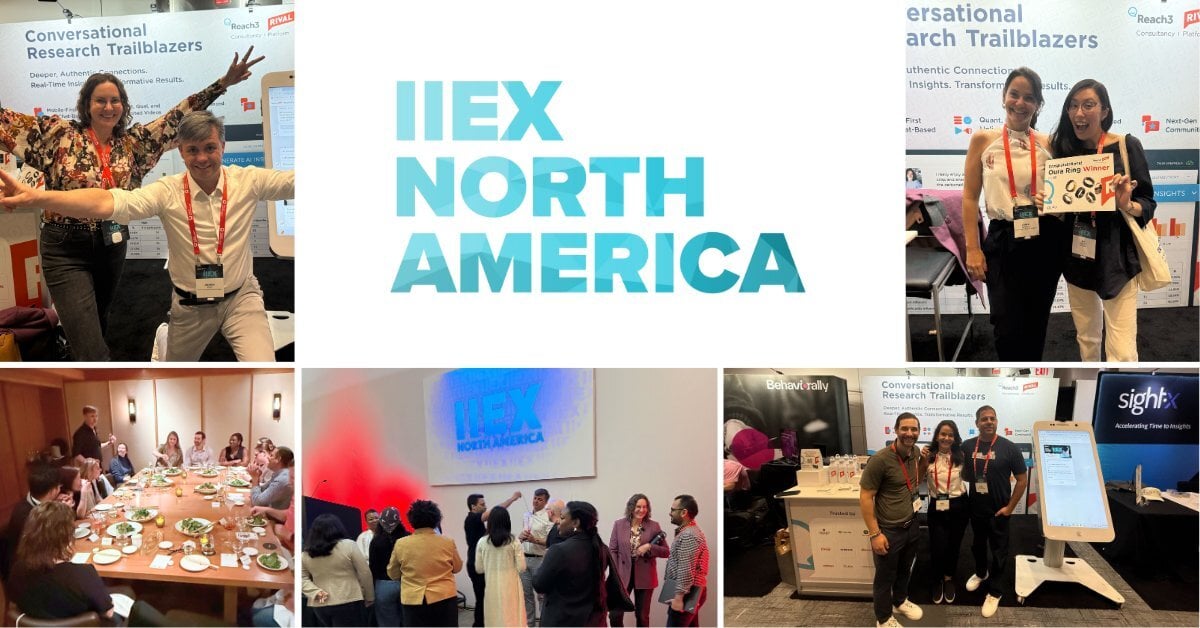
I just got back from IIEX North America 2025, and wow—what a ride. The energy was high, the ideas were flowing, and the future of market research feels more alive (and urgent) than ever.
There were some clear themes across sessions and hallway conversations: AI is evolving, conversational research is maturing, and we’ve got to stop treating participants like data sources and start treating them like people.
Here are the big takeaways.
No surprise—AI was everywhere. But this year felt different. Less flash, more substance. The conversation is shifting from hype to application: how can AI actually make research better, faster, more useful?
I saw everything from purpose-built market research platforms doing impressive things with unstructured data to vendors still tacking “AI” onto their booth signage without much depth. But overall, the industry is starting to move beyond experimentation and toward integration—where AI isn’t the headline, it’s just how things work smarter.
One standout session from Lorin Drake struck a chord with me: we’re stuck thinking in silos—chatbot or video or survey. But participants don’t think that way. A smart, seamless blend of methods can make the research experience feel intuitive, engaging, and even enjoyable.
Think of it this way: a mobile-first flow that feels like a text thread, uses a chatbot to probe deeper, and offers a quick video upload when words aren’t enough. That’s what conversational research should look like—natural, flexible, and built for how people actually communicate.
The best conversational research isn’t about bots pretending to be human—it’s about conversations that are human, whether or not a bot is involved. We need to stop designing studies that feel like standardized tests and start building experiences that mirror how people actually talk: short exchanges, optional media, room for real emotion.
If we want honest, rich responses, we need to meet people where they are—and speak their language.
Did you love taking tests in school? Most research participants likely do not yet most survey feel a heck of a lot like a test experience they you are dying to get out of the second you begin.
While I missed the official session on data quality and trust, the hallway buzz made one thing clear: this remains a major concern. As new vendors pop up and scale fast, the pressure to hit quotas can overshadow participant experience.
Transparency, respect, and frictionless experiences aren’t nice-to-haves.
Here’s the reality: we can’t get quality insights without quality engagement. And we won’t get quality engagement if participants feel like they’re just a line item. Transparency, respect, and frictionless experiences aren’t nice-to-haves—they’re table stakes.
One of the most underrated tools right now? SMS.
We’re seeing north of 60% re-engagement rates when people are invited via text—because it feels personal and easy. When combined with memory (i.e., the platform recalls what they’ve shared before), it creates a sense of continuity. That familiarity builds trust—and better data.
Participants shouldn’t feel like they’re starting from scratch every time. Let them choose their channel—SMS, Slack, Discord, X, WhatsApp—and respect that choice. Flexibility builds loyalty.
Research platforms that remember past interactions, preferences, and context are the future. It’s not just about personalization—it’s about designing ongoing relationships. When every new touchpoint builds on the last, you get deeper insights, faster. If conducting customer research layer in behavioral and transaction data to create a better experience and more valuable data sets.
Think of it like a CRM for participant insight. It’s how we go from episodic research to continuous understanding.
IIEX 2025 was a reminder that conversational research is evolving fast—and it’s ours to shape. This isn’t about choosing between humans or AI. It’s about creating experiences that reflect how people think, feel, and communicate—and using technology to support that, not replace it.
Subscribe to our blog to receive the latest news, trends and best practices from market research experts.


No Comments Yet
Let us know what you think